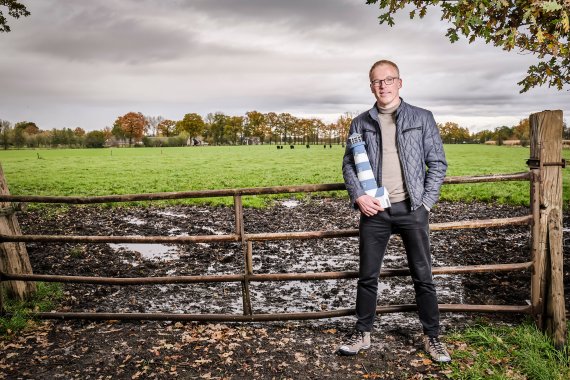If there is one thing Rogier Schulte wants to avoid, it is the usual antagonism between organic and conventional farming. The professor of Farming Systems Ecology would rather leave this outdated distinction behind altogether. He prefers to talk in terms of lighthouse farms: models of sustainable farming and ‘food landscapes’ that are fundamentally different to the current system. ‘I’m looking for farms that are ready for 2050.’
Cows and caviar
The innovation at these model farms goes way beyond the way they produce food. ‘Take our lighthouse farm in Latvia,’ says Schulte. ‘That’s an industrial farm with 1000 cows. The milk is a by-product; the main product is manure, which will generate biogas in seven digesters. That gas will be converted into electricity for homes, but even that is a by-product. The main product is heat with which the farmers heat fish tanks for raising sturgeon and eels. The fish is yet another by-product because what this is really all about is the fish eggs, or caviar. Caviar is expensive, so from an economics point of view, this is a caviar farm, where cows produce one of the necessary inputs. If we see it in terms of biomass, this is primarily a dairy farm. And it is also an energy company, providing heat for 2500 households.’
What is so interesting to you about this farm?
‘We have several selection criteria. Firstly: the farm is fundamentally different to other dairy or caviar farms at the system level. Secondly: the farm is economically viable. Thirdly: the farm is part of a community; its production system reaches beyond the farm. And fourthly: the farm shines in at least one aspect of sustainability. In this case, it is circular agriculture that the farm does well. Our lighthouse farms don’t have to score highly on all aspects of sustainability; they have to be radically innovative in one aspect of it. Between them, they show what is possible.’
The more complex the food system, the more income and biodiversity it generates
Is this about ecological or circular agriculture?
‘There are two dominant interpretations of circular agriculture in the Netherlands. One of them focusses on the manure and argues for a nutrient cycle. The other focusses on the valorization of waste products and reducing food waste. I argue for a broader perspective. I want to let go of the distinction between main product and by-product. There are flows of material, energy and money that you need to link up with each other. That might sound a bit wishy-washy, but look at the farm in Latvia that produces food and energy, and makes money in a sustainable fashion.’
What kinds of research questions are thrown up by these farms?
‘These are farmers who are eager to learn and they all have different knowledge needs. We send our MSc students to them for internships, so they can carry on learning together. One important question is about the scale on which we can implement circular farming. We are now looking at circularity in Amsterdam. A household can be circular, and schools or Artis Zoo can be circular, but each to a different extent. An Amsterdam household might buy food from a farm in Waterland which is circular too, but there will always be external circles as well because, for example, we are not going to grow coffee in the Amsterdam area. So you get a number of circles, and the food circles are on a different scale to the energy circles.’
Is that reflected in the lighthouse farms?
‘In Finland we are studying three ecological farms that are producing food and gas together. That energy is sold locally, so you get a local energy circle. But that local circle is part of a European sustainable energy system in which wind turbines in Germany are linked with solar panels in Spain so that European residents always have electricity. So we are talking about local circles of energy and food that together form a network.’
What is the link with nature?
‘In Indonesia, our PhD student Uma Khumairoh has been studying nature-inclusive rice farming. By combining growing rice with growing duckweed and border plants and keeping ducks and fish, you get a farming system that makes more money, makes full use of nutrients and suppresses diseases. This is about a collection of functions; you are building a food ecosystem. This complex system generates more money and biodiversity than specialized rice farming alone. Dozens of farms on Java are already practising it. We are also doing research on the development of a food forest in a tract of cleared rain forest in Brazil. Vegetables, bananas and eucalyptus will be grown on the bare forest soil: fast-growing crops that are pruned frequently and deposit a lot of organic material in the ground so that a thick layer of humus is built up over five years. We are comparing this food forest with traditional farming systems such as pineapple farming and livestock farming. Here again, you see that the more complex the food system, the more income and biodiversity it generates. The challenge is: how can we make use of biological knowledge and manage the complexity?
Do you work together with other Wageningen groups?
‘We participate in one of WUR’s investment themes called Connected Circularity, in which we and other groups aim to arrive at a shared vision and joint research. At first it was like the tower of Babel, with great confusion about what everyone understood by circularity. The animal scientists talk about manure, nutrition researchers talk about food waste and food technologists talk about product quality. It is nice that WUR is now allocating funding to reflection aimed at arriving at a shared vision on circularity.’

 Photo: Guy Ackermans
Photo: Guy Ackermans